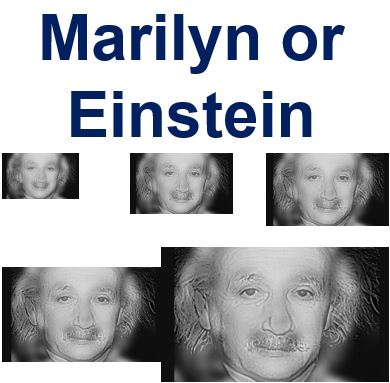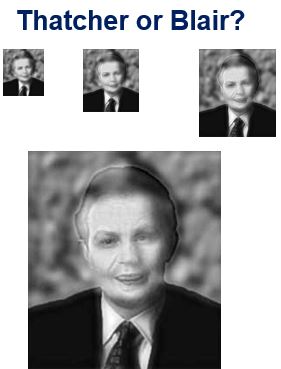An Einstein-Monroe hybrid image that combines low spatial frequency components of a photo of Marilyn Monroe and high spatial frequency components of an image of Albert Einstein can tell you whether you need to wear glasses.
When the picture is small you see Monroe, as it grows you should start seeing Einstein until the physics genius takes over completely. That is, of course, if your eyesight is good. If you need glasses you will continue seeing Monroe as the photograph grows.
The same applies to distance. If you stand far away you see the 1950s actress. As you get nearer the theoretical physicist will gradually take over – if your eyesight is good.

If the small image of Marilyn Monroe does not turn into Albert Einstein as you progress to the larger images, you need to wear glasses (or need new glasses). (Image: MIT)
What are hybrid images?
Hybrid images are static pictures with two possible interpretations that change depending on the viewing size or distance.
Two years ago, Aude Oliva, from the Computer Science and Artificial Intelligence Laboratory at Massachusetts Institute of Technology (MIT), wrote in the journal Art & Perception:
“The phenomenon of hybrid images arises from the multi-scale processing of images in the human visual system.”
“By taking into account perceptual grouping mechanisms, one can build compelling hybrid images with two different stable interpretations: one that appears when the image is viewed up-close, and the other that appears from afar.”
“Hybrid images can be used to create compelling prints and photographs in which the observer experiences different percepts when interacting with the image.”
Dr. Oliva, a Principal Research Scientist at the MIT Computer Vision & Graphics Group, has spent over a decade creating hybrid optical illusions.

Recent video explains hybrid images
In a recent video, AsapScience, a YouTube channel created by Mitchell Moffit and Gregory Brown that produces weekly videos that touch on many different topics of science, highlighted the processes behind hybrid images.
Brown and Moffit said:
“Depending on how well you’re able to focus or pick up contrast your eye will only pick out details. Up close, we’re generally able to pick up fine details like Einstein’s moustache and wrinkles.”
“But as the distance increases, or if your vision is poor and creates a more blurred image in the first place, your ability to pick up details fades away. Instead you only see general features, like the shape of mouth, nose and hair, and are left seeing Marilyn Monroe.”
